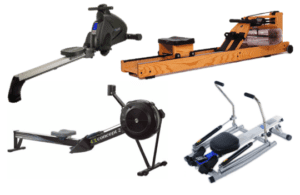
Choosing from so many different brands, price ranges, features, and warranties can really give you a headache.
One of the most important things to consider when looking for a rowing machine are the different rowing machine resistance types.
The resistance type can usually determine the cost, monitor functionality, build quality, and size of the rowing machine.
Determining which rowing machine resistance type you like best will also help narrow down your options the most!
Basically, choosing a resistance type is one of the most important decisions when choosing a rower.
While choosing which rowing machine to buy can be difficult, just know choosing to buy a rowing machine in the first place is the right choice!
Rowing machines provide the best full-body workouts and burn more calories than any other piece of exercise equipment. They are also low impact and can be used by virtually anyone!
Why Resistance Type is Important?
Each type of resistance provides the user with a different rowing experience and usually has a list of unique characteristics tied to them.
These characteristics can range from noise level, price, size, and storage capabilities.
Some characteristics you want may match up to a particular rowing machine resistance type.
Once you figure out your preferred resistance type your search becomes much easier and more efficient. You can rule out all other rowers that aren’t in your resistance category and vastly narrow down the search field.
For example, a search on Amazon for “rowing machine” returns 169 results (not all rowing machines). If I were to decide I want an air rowing machine, it would narrow the field down to less than 10 options!
This makes managing your search a heck of a lot easier!
You can go a step further and choose a price range, which may only leave you with 1 or 2 options.
Rowing Machine Resistance Types
Rowing machines try to simulate outdoor rowing. The different indoor rowing machines provide resistance using 4 different resistance types: air, hydraulic-piston, magnetic, and water.
There is now a new type of resistance, which is a combination of air and magnetic.
I’ll go into each resistance type below and cover key characteristics.
Keep in mind, the information is a broad overview of each resistance-type and the characteristics may vary depending on manufacturer, price, etc..
To get the best information it’s best to select a rowing machine and read the full review.
So without further ado, here are your 5 rowing machine resistance types:
Air Resistance
Air-resistance rowing machines get their resistance from a spinning fan flywheel.
When a rower pulls on the handle, it causes the flywheel to spin and create wind. The harder the handle is pulled, the more wind is created.
The more wind created, the more difficult it gets to pull the handle, and the more resistance the user feels.
Thus, the resistance level is directly related to how hard/ fast you row by pulling the handle.
This is what makes this resistance type “variable”. Due to the fact that the user controls the resistance level by how hard they row.
On a treadmill, you set the speed at “x” and keep running at that speed until you either change the speed on the monitor or you turn it off. An air rower allows you to slow down or speed up your rowing pace in the middle of your workout without touching anythings. The resistance will adjust accordingly.
For this reason, air resistance rowing machines are very popular for HIIT (high intensity interval training) and Crossfit workouts. They allow users to row intensely for one set and then easy the next, without stopping or changing any settings.
Air resistance typically has a large footprint due to its long seat rail. This plays a vital role in providing a smooth rowing motion.
It is the chosen resistance type for Olympic athletes to use when rowing off the water. Mainly due to their strong resistance levels, smooth motion, and realistic feel.
The rower simulates rowing outdoors very well and is not as costly as a water-resistance rower.
The only downside to air resistance rowers are they make a bit of noise. The spinning flywheel creates a ‘whooshing’ noise every time you pull the handle. This is irritating to some people who want to row while watching TV at a normal volume.
Characteristics
Price Range: ~$300 – $1,300
Size: Usually has larger footprint relative to the other resistance-types due to a longer seat rail.
Storage: Most have an option to take the unit apart/ fold the unit in half for storage.
Adjustability: Resistance is ‘variable’ based on the users rowing intensity. Higher-priced models usually have an option to further adjust air-flow into the flywheel.
Noise-level: Loudest of all resistance-types due to the constant spinning of the flywheel.
Rowing Motion: Resembles outdoor rowing. Smooth and strong. Recommended by Olympic athletes.
Ideal for: People of all fitness levels (beginner, intermediate, advanced). Rowers looking for an off-season training tool. All people looking to get a total body workout.
Misc: The longer rails make it suitable for taller rowers with long legs. Concept2 also sells longer seat rails to accommodate very tall users.
Popular Brands: Concept2, Stamina
Most Popular Rower:
- Concept2 Model D Indoor Rower (#1 Bestselling Rowing Machine)
- Stamina Air Rower 1399 (Best Budget Air Rower)
Magnetic
Magnetic resistance rowing machines use a magnetic brake system to create resistance.
As a metal flywheel spins, a magnet can be moved closer or farther away to create more or less resistance.
Magnetic resistance produces no friction and is virtually silent.
Resistance is ‘adjustable’ and the footprint is fairly large due to a long seat rail. The size is similar to an air-resistance rower.
These rowers can vary in price and quality and are found in each category. Many users love these rowers because they provide the same smooth rowing motion as air rowers but are quiet like hydraulic-piston rowers.
Sort of a “best of both worlds” scenario.
When comparing air & magnetic, on the plus side a magnetic rower is much quieter but on the minus side the rowing motion isn’t as smooth/realistic as an air rower.
I also feel the resistance is weaker on magnetic rowers and you can get a better overall workout on air or water resistance rowers.
As of recently, magnetic rowers have become very popular in the lower price ranges. People really enjoy rowing while watching TV but still feel they can get a good quality rower with strong resistance.
Read my ‘Final Thoughts’ section for a full breakdown on the comparison of resistance-types.
Characteristics
Price Range: ~$200 – $1,400
Size: Usually has a bigger footprint due to a longer seat rail.
Storage: Most have an option to take the unit apart/ fold the unit in half for storage.
Adjustability: Usually has a resistance-level setting. Can adjust by turning a knob or pressing a button on higher priced models.
Noise-level: Quiet
Rowing Motion: Similar to air-resistance but not as smooth or strong.
Ideal for: People of all fitness levels (beginner, intermediate, advanced). People who want great workout without the noise of air or water rowers.
Misc: Its size is similar to an air-rower but it isn’t noisy. Cost is usually mid-range.
Popular Brands: Stamina, Velocity, Lifespan, LifeCore
Most Popular Rower:
- Stamina Avari Magnetic Exercise Rower ($500-$999 Price Range)
- Sunny Health & Fitness SF-RW5515 Rower ($249 & Under Price Range)
Air/Magnetic Resistance
After describing both air and magnetic rowing machines, I figured it would be fitting to outline the air/magnetic combination rowers.
Combination air/magnetic rowers are truly a blend of both air and magnetic resistance.
Rowers will have the ability to adjust magnetic tension by moving a magnetic closer or farther from a metal flywheel. They will also have the ability to row faster and feel more resistance from the added “air” resistance.
Users will enjoy the benefit of having the low-end power of magnetic resistance and the high-end power of air resistance.
Combination rowers are usually in the higher price ranges and have fairly advanced monitors. They also have good build quality and higher weight & height capacities.
The resistance on combination rowing machines is usually the strongest due to having two resistance mechanisms working at the same time.
This is great for some people, but it doesn’t closely mimic the resistance felt from “on the water” rowing, which is a downside for others.
Characteristics
Price Range: $300 – $1,500
Size: Large footprint due to a longer seat rail.
Storage: Most can be folded for storage.
Adjustability: Has low-end power of ‘adjustable’ magnetic resistance, combine with high-end power of ‘variable’ air resistance.
Noise-level: Quieter than an air-only rower but louder than magnetic-only rower. Fan will not spin as fast as air-only rower which makes it slightly quieter.
Rowing Motion: Closely resembles outdoor rowing but resistance will feel heavier.
Ideal for: People of all fitness levels (beginner, intermediate, advanced). Rowers looking to have strong resistance. Ability to have adjustable resistance and pre-set workout programs on high-end models.
Misc: Some model have ability to control resistance in handle
Popular Brands: LifeCore, Sole
Most Popular Rower: LifeCore R100 Rowing Machine
Water Resistance
Water resistance rowing machines use paddles suspended in a tank of water to create resistance.
When the handle of the rower is pulled, the paddles spin in the water creating resistance that feels very similar to rowing in a boat.
The harder the handle is pulled, the faster the paddles spin. The faster the paddles spin, the more difficult it gets to pull the handle, and the user feels more resistance.
Thus, the resistance level is directly related to how hard/ fast you row by pulling the handle.
If you’re wondering why this description sounds so familiar, it’s because this rower functions very similarly to an air-resistance rower. The main difference being water is being used instead of “air” to create resistance.
Like an air-rower, resistance-level is determined by rowing intensity, making the resistance “variable”.
In addition, the rowing experience can be further adjusted by managing how much water is in the tank. The more water, the “heavier” the rowing will feel (like rowing with passengers in a boat). The less water, the “lighter” the rowing will feel (like rowing by yourself).
Water rowers usually have a large footprint and are heavy due to the water tank.
They make a fair amount of noise but users consider the sound of the water to be soothing and relaxing.
The noise falls somewhere between an air rower and magnetic rower.
There are some claims that water resistance rowers provide the smoothest rowing motion out of all the resistance types. They do feel incredibly smooth!
The brand WaterRower also made them very popular by handcrafting the rowers out of beautiful wood that can look like a piece of home decor. Maybe you’ve seen one in use on House of Cards?
Water resistance rowers are also notoriously expensive, although some mid-range options exist.
Characteristics
Price Range: ~$700 – $2,000
Size: Large footprint due to a longer seat rail. Fairly heavy due to the water tank.
Storage: A lot of the rowers can be stored standing upright. The footprint becomes the same as a dining room chair.
Adjustability: Resistance-type is considered ‘variable’, based on the resistance being directly related to the rowing intensity. Rowing experience can be further adjusted by managing the amount of water you put in the water tank.
Noise-level: You will hear the paddles splashing in the water, but it’s not as loud as an air-rower.
Rowing Motion: Closely resembles outdoor rowing.
Ideal for: People of all fitness levels (beginner, intermediate, advanced). Rowers looking for an indoor training machine. People who want aesthetically pleasing rower to have in their living room.
Misc: Possibly the closest experience to rowing on water.
Popular Brands: WaterRower, First Degree Fitness
Most Popular Rower: WaterRower Natural Rowing Machine
WaterRower makes a full line up of rowing machines that all function exactly alike. The major difference between models is the wood they are constructed from, which changes the price.
Check out the full WaterRower lineup here.
Hydraulic Piston Resistance
Hydraulic piston rowing machines get their resistance from… you guessed it, hydraulic pistons!
Most rowers have 2 pistons, 1 is attached to each arm of the handlebar. Others have 1 center piston.
2 Piston Hydraulic-Piston Rower
1 Piston Hydraulic-Piston Rower
These rowers have ‘adjustable’ resistance that is controlled by turning a knob on the piston.
Levels usually range from 1-8 and control the amount of fluid allowed to move in-and-out of the piston. Thus, controlling the resistance.
Hydraulic-piston resistance is the only type that allows an independent workout for each arm. Meaning each arm works out independently of the other (on 2-piston rowers)
This can be great for rehab and correcting muscle imbalances.
The main benefits of hydraulic-piston rowing machines are they are very quiet and extremely affordable. These rowers dominate the low-price range market.
The pistons make very little noise and can be used while watching TV. Hydraulic-piston rowers are also compact making them great for use in small areas and is easy to store.
However, being compact doesn’t make them a good choice for very tall and heavy users.
The build quality on hydraulic-piston rowers can also be a bit lower than other models.
One result of this lower build quality is the pistons can get hot while working out for long periods of time. This can cause them to overheat and sometime leak oil.
While this is rare, it can happen and I recommend keeping a mat underneath the rower like the Fold-to-Fit Folding Exercise Equipment Mat.
Due to the pistons overheating, it is also recommended to only use hydraulic-piston rowers for about 20 minutes at a time.
So if you are looking for some serious cardio, you may want to look into other rowing machine resistance types.
Characteristics
Price Range: ~$100 – $600
Size: Smallest footprint out of all the resistance-types.
Storage: Smaller footprint makes it easy to store. Some models have the option to fold up which saves even more space and provides more storing options. Very light weight.
Adjustability: The pistons usually have a resistance-level setting.
Noise-level: Quiet
Rowing Motion: Rowing motion provides a good full-body workout, but the motion is typically the least similar to rowing outdoors. Not as smooth as other resistance types.
Ideal for: People with beginner and intermediate fitness levels. People looking for a beginner rowing machine. Elderly rowers. Not recommended for athletes.
Misc: Not the best option for taller users due to the smaller seat rail.
Popular Brands: Stamina, Kettler
Most Popular Rower: Stamina 1215 Orbital Rower
Next Step/ Final Thoughts
Now that you are familiar with all the resistance types, you can narrow down which types you like and which you don’t.
The more you can rule out, the easier you final decision will be.
If you are having trouble deciding between two different resistance types you can read my comparison articles. They will further break down each type and help compare between the two.
- Air vs. Magnetic Rowing Machine Resistance Comparison
- Water vs. Air Rowing Machine Resistance Comparison
Now that you have decided which rowing machine resistance type best fits you, check out the different models!
Visit the Rowing Machine King Comparison Chart and also filter by characteristics such as price and size.
If you really can’t decide which rowing machine you want and you feel like your head is going to explode, then let me choose a model for you!
Yes, just fill out my rowing machine questionnaire and I will select which model fits you best. I call it “The Personal Rowing Machine Concierge“.
I hope you enjoyed my overview of the different rowing machine resistance types. If you have any questions please leave them in the comment section below.

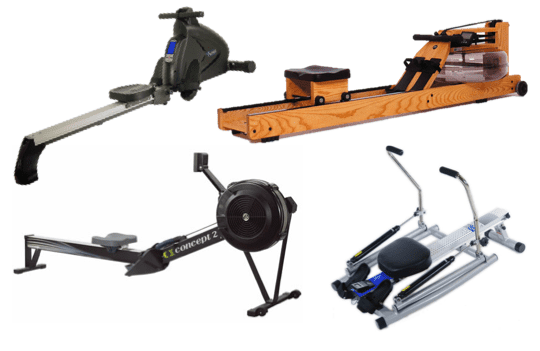
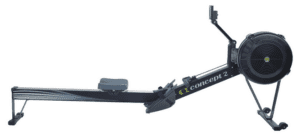
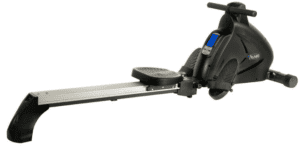
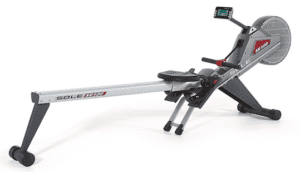

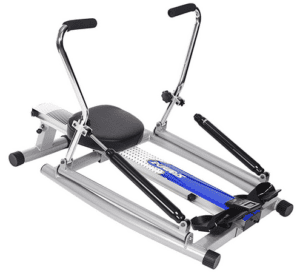
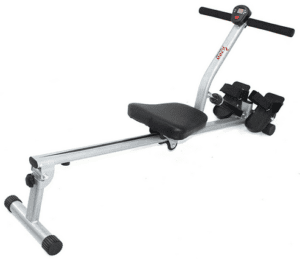
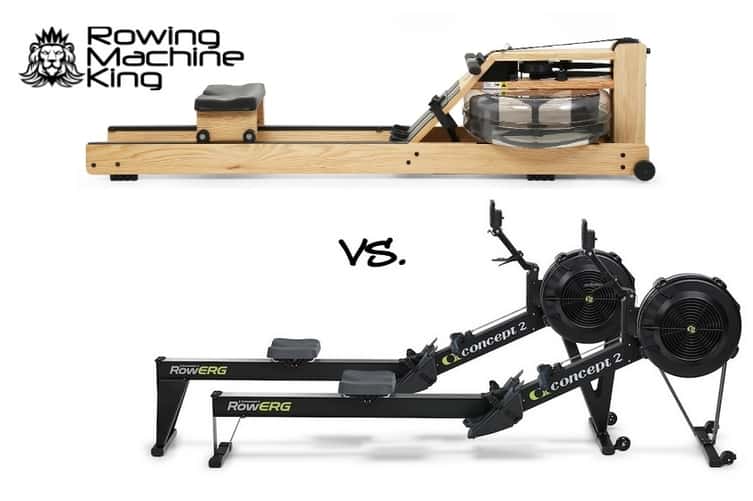
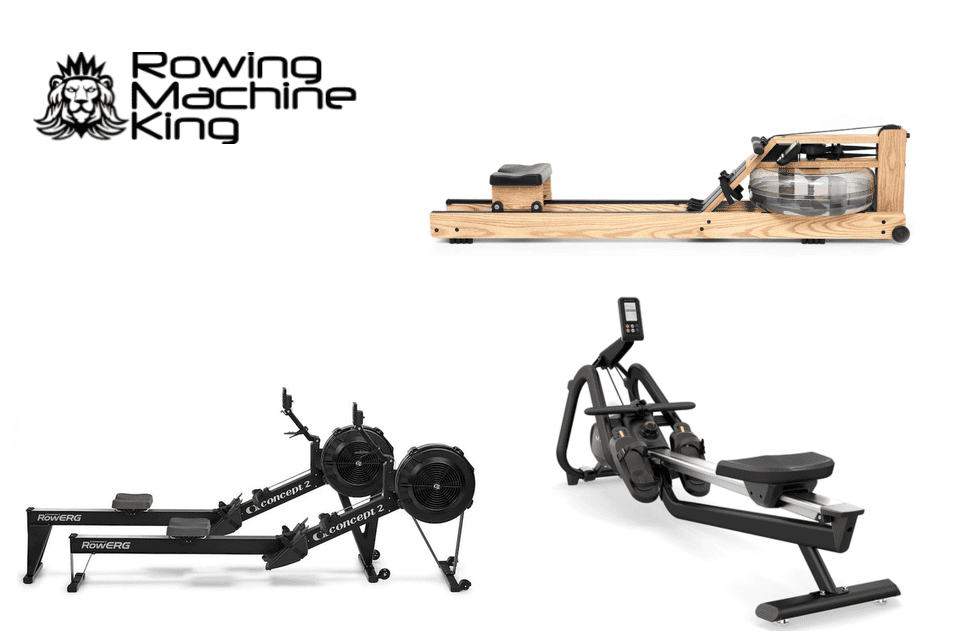
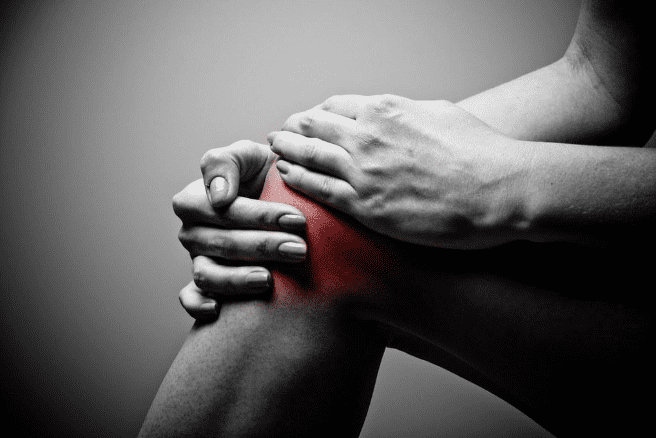
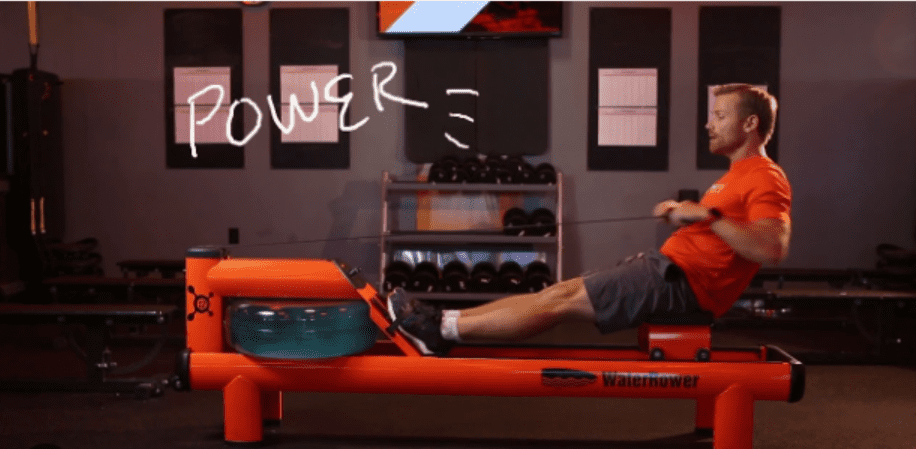
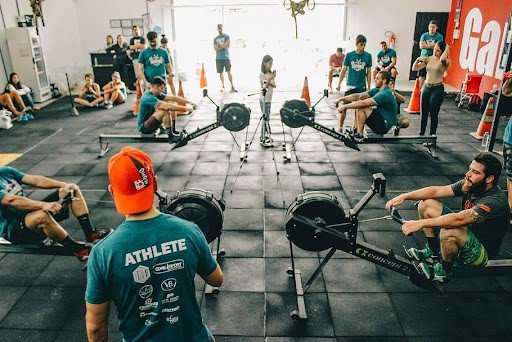
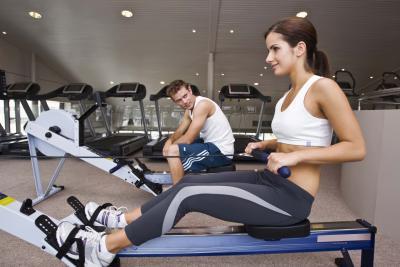
Just purchased a Velocity Magnetic Rowing Machine. It will be in a low pile carpeted room. Do I need to put a pvc mat underneath it?
Thanks
Hi and congratulations on your purchase of the Velocity Fitness Magnetic Rower! The rower uses magnetic resistance so you don’t have to worry about anything leaking. In addition, it’s sturdy so you don’t have to worry about it rocking back and forth. However, just to be on the safe side since it’s going to be used on low pile carpet, I would definitely put a pvc mat underneath it. You can do without it, but it would be ideal. Let me know if you have any other questions!
How much more resistence would the water rower give compared to the air rower?
I am searching for a rowing machine, and see a less expensive magnetic model of the same brand, and a more expensive “induction” model. What is an “induction” system resistance type? Sorry the website I included is in French…it’s the systeme de freins
Hi Marie,
An induction braking system is a magnetic braking system. If you look up “Induction Braking” or “Eddy Current Brake” you can find more information relating to the topic.
Here are 2 links to some helpful sites: Eddy Current Brakes Wiki and Induction Brake System.
Hope this helped! Thanks for checking in
Great article… a quick question on hydraulic rowers. How long should the pistons last? And are there certain types of rowing that will shorten their life? Ways to lengthen their life. I like the idea of a hydraulic rower because it will be easier to fit in my house, but I am afraid of getting a money pit where I will have to replace pistons every few months.
Great question and one that is difficult to answer! It really varies a lot and depends on the model and usage.
Lower priced rowing machines (under $200) should last at least a year with moderate to light rowing. This would be around 30 minutes a few times a week. Most manuals state that you should not use the rower for more than 15-20 minutes because the hydraulic-piston can get very hot and malfunction. I usually recommend people stop after 15 minutes, perform another exercise such as push-ups/sit-ups, and then row again.
The higher the price, the higher the quality of the pistons. Any of the Kettler hydraulic-piston rowers will last longer and also have longer warranties. These can also be used for longer sessions and more vigorous rowing.
A majority of people have pistons that last multiple years and have no issues but there is a small percent that have pistons fail after a few months.
Thanks for your answer. One follow up question if I might. I noticed that there seems to be two ways resistance is adjusted on hydraulic cylinders. In the first case, like on the Kettler Favorit or the Stamina 1215, the piston seems to have a constant resistance and rower resistance is adjusted by changing the angle of the handles to the cylinder. On others like the Kettler Kadett and the Stamina 1050, there is a dial on the cylinder to adjust the resistance. Is one style more durable than the other?
I don’t believe one would be more durable than the other and I have not seen one style have more complaints than the other.
There is the slight possibility that the “dial” cylinder could be less durable due to more mechanical components, where the other style just increases the angle to require more force to move.
I’m a 77 yr old, reasonably healthy female looking for a rower that I can fold up and stow in a corner after use. I currently have a treadmill, which, after 12 years, I’m getting bored with. If rowing agrees with me I will get rid of the treadmill and use the space for the rower. My concerns are weight, ease of folding and a mat light enough to be rolled up. I certainly couldn’t move the one under my treadmill.
Hi Sandra – if you would like to fill out my concierge form I can give you some suggestions. Thanks!
I’m researching rowers and just saw an inclined rower. Which one would be better for working my abdominals, incline or standard rowers?
Hi Lesa,
Thank you for reaching out! A standard rower will probably allow you to lean back more which will work out your abdominals a bit more. The difference is probably marginal though. Nothing beats doing standard sit-ups, crunches, and planks for an abdominal workout :)
I AM LOOKING FOR A BEGINNER ROWER THAT HAS RESISTANCE IN THE SEAT FOR A GOOD WORKOUT & FOR MY LEGS & GLUTS. THIS DETAIL IS HARD TO DECIPHER IN THE PRODUCT DESCRIPTION OR MAYBE I’M NOT ASKING THE RIGHT QUESTION. THANKS SO MUCH. SORRY FOR THE CAPS, MY KEY I STUCK (LOL)!
Hi Nicole,
No problem about the caps lol! Your question is a bit confusing because it seems like you are asking if the seat itself has resistance on a rowing machine.
The resistance on a rowing machine is provided by the handle. However, you drive with your legs first to pull the handle so you do feel the resistance in your legs/seat.
You can fill out my rowing machine concierge form and I can direct you to more information and the best models.
Thanks!
Hi Edwin
I am thinking to buy the ARC-102 rowing machine what is opinion.
Thanks
Where are you buying it from and for how much?
Hi, I want to buy a rower for home-use, to get in shape. I hate running but I love a “hard” work-out so I want to make sure the resistance on my new machine is adequate. So, in your opinion, what’s the best budget-friendly, home use machine? And how do I make sure I don’t buy a cat-in-the-bag?
By the way, I live in Russia so my options aren’t as varied, but there seem to be a few different brands available.
Thanks in advance!
Hi Este,
I would first choose a resistance type and then pick a price range. Once you narrow down your resistance and price, you shouldn’t have many options left.
Unfortunately, I don’t know any of the models that are offered in Russia. If you find one you like you can send me the link at Edwin@rowingmachineking.com and I can take a look at if for you :)
Thanks for the explanations of various rowing machines.
I have a fundamental question about the resistance of each type of machine…
Since I row both in single sculls and in coxed 4 and 8 person shells during the summer and want a good erg for the winter to keep my 78 year old body in shape.
I have used a newer model Concept 2 erg at my rowing club which has adjustable air drag and a water rowing erg at my YMCA. NEITHER one of these machines have full resistance at the initiation of the stroke like an oar does when you start your stroke, pulling against the water. Each of these machines has essentially no resistance until the stroke is about 1/8-1/4 complete and the “slack” in the mechanism is taken up. I want a machine with full resistance from the moment I start my stroke, with full resistance just like the oar gives when rowing in either a single scull or in a shell.
Do you know of ANY style of machine with this capability???
Hi Charles,
I’m afraid not. The Concept2 is the most widely used rowing machine by rowers and it is the only rowing machine used in indoor rowing competitions and for world records.
There are some higher cost rowing machines like the RP3 but I believe they will function very similar to the C2. Sometimes there’s just no substitution for the real thing!
I am thinking of getting my first rowing machine. I am looking at the r100 or a concept 2. Which do you think would give me the best consistent resistence and program workout options
Hi Richard,
I really like the Concept2 Rowers. They have great resistance and are the chosen rowing machine in most gyms. They also have an excellent monitor that is super accurate and has a ton of features!
I think Edwin is spot on here. The concept2 rowers are the standard by which all other rowers are measured. They durable, the standard choice of rowing clubs, and hold their value really well.
There are other good rowing machines out there, but from what I can see quality of the workout and durability are not reason to choose those. You choose the others based on price, available space, or you perhaps you don’t like the noise the rower makes.
Hi!
Are orbital rowers better than non-orbital rowers?
It’s really a personal preference but a lot of people like orbital rowers because you can vary the different angles as you pull the handles back.
I just started looking and was wondering what your thoughts on the inspire cr2 bi-directional tower are. Thx
Hi Edward,
I haven’t done much research on the Inspire Fitness CR2 but my initial thoughts are it could be tough on your back. It’s also much different than a traditional rower.
A traditional rower you can have a strong back and sit upright throughout the motion. While you pivot back and forth, there should never be a “slouching” form that it looks like you would have to do on the CR2.
I personally would save myself some $$ and get the Concept2 Model D and if you are wanting to get a little “pushing” resistance then do a few sets of pushups.
Honestly, I feel the Inspire Fitness CR2 is a bit of a gimmick and I’d like to see some more qualified physiologist give some recommendations. The Concept2 Rowers and other rowing machines are using in rehab facilities so I know they won’t cause injuries if used properly. I feel this machine might add too much stress on the back.
Hopefully I can do a full review one day to give a more educated response.
Thanks for your input I think I will go with the concept 2.
Hi,
There is one thing that is never mentioned when talking about piston machines – movement of arms. With so called better rowing ergs you pull a bar in quite a monotonous way, but with dual piston machine your arms can be spread a little bit. Also, there is a little bit resistance while pushing “oars” forward. I use a piston machine in winter as here in Finland lakes are frosen. I don’t row when waters are open, but paddle instead, so that may be a reason why I assume that piston machine is better in my case. – Just thoughs, anyway… not sure, whether they really matter.
I’m looking for a decent budget rower – nothing fancy, just something I can stick in the corner against the wall and occasionally row on to lose weight. After reading your articles, I’m gravitating towards the Sunny SF-RW5639 but noted your comment about tall users. What exactly are you considering “tall” for the purposes of these rowing machines? I’m 6’1″ and almost 300lbs, so I didn’t want to spend $130 on one that shoves my knees up my nose…
Thanks for the great articles and information!
You should be fine at 6’1″. I have a capacity section in each review where I usually mention the tallest height a person can be on the rower. Most rowers can fit people up to 6’4″ tall.
I believe the SF-RW5639 has been used by people taller than you.
I also have an article that lists out all the models with capacities over 250 lbs., which is where most lower cost rowers go up to. Check it out here: https://rowingmachineking.com/high-weight-capacity-rowing-machine-models/
It’s 2019 and you’re still helping people make informed decisions! My wife and I used this article to educate ourselves and we enjoyed your thoughtful approach to the topic. I was hesitant about air resistance machines but your breakdown helped me develop a better framework to analyze our needs.
Thank you for the work you have done which surely countless strangers have benefitted from. We wish you the best!
Hi Daniel – thank you for the kinds words! I really appreciate it. I’m glad you found the articles helpful!
Hi Edwin. Great article. I’m trying to buy an air flow rowing machine in Dublin. One of the affordable options is Body Train rowing machine. Is it a good option?
https://www.irishsportswarehouse.ie/bodytrain-gb-hc8806-air-rowing-machine
Hi Umair- thank you for reaching out! Unfortunately, I don’t have experience with that brand (as it’s not offered in the US) but it looks similar to the Stamina X or Stamina 35-1405 that I have reviewed. Sorry I can’t be of better help!
Thanks a lot Edwin. The one I got has a chain (like in bicycles) attached to the wheel / handle. Is it normal for rowers to have that or do most of them use a cable?
Regards
Yes, a lot of rowers have a chain. The most popular model – the Concept2 – has a chain. Other’s use a “cable” probably because they cost less and can sometimes make a little less noise.
Thanks a lot. Another problem I’m having is that the foot pedals are non adjustable and seem to be placed too low. I don’t feel that the angle is right when I’m rowing. Any ideas what can I do to make it feel better?
Regards
Umair
Hi Umair – sorry, I’m not aware of a fix for foot pedals being placed too low. Maybe putting something in the heel cup to raise your feet up a little higher?
Hi,
I am a beginner rower. I am looking at the share vgo rower. What are your thoughts? I read some users found the 8 resistance levels to not be enough. I thought most rowers had 8 resistance levels? I have only seen a couple mid range rowers have more than that. I know resistance is subjective to each person but I want a good work
out. Any insight will help. Thanks in advance.
Hi Tara – thank you for reaching out! Unfortunately, I haven’t done a full review of the ShareVgo Rower so it’s hard for me to give an opinion. At first glance it looks decent enough, especially when a lot of the other rowers are sold out. Sorry I can’t be of better help.
Ok thank you! I am also considering the maxkare magnetic rowing machine with 16 tension levels, as opposed to this one only having 8. My concern is that the highest level of tension on the sharevgo will eventually be too little. Have you used the maxkare at all to know how the tension is for that one?
Hi Tara – unfortunately, I haven’t used the Maxkare rowers. I am planning on reviewing them next but usually if the flywheel is the same weight/size (sometimes this info is not given) the resistance is the same. Some models just give more adjustments but it doesn’t necessarily mean it has more resistance strength. So level 8 would equal level 16. I’m not sure if this is the case between the Maxkare and ShareVgo.
Hi
I am looking to buy a rowing machine for my husband, but we are on a budget. He does suffer from achilles tendonitis. Are there any rowing machines you wouldn’t recommend with that kind of injury.
Thanks
Hi Louise – thank you for reaching out! All rowing machines will have the same basic movement which means there is no particular model that would be better for that type of injury. Most lower priced rowers will have pivoting footrests which should allow for more movement of the ankle and achilles so that could be something to look for.
Thank you very much for your help. I will look for one with pivoting footrests.
Regards
You’re welcome Louise and good luck!
Hi there, I’ve done a lot of research on the difference between magnetic and air rowers. All seem to say the resistance on magnetic is slightly less than air.
But my main question is by how much? I’m a 27 year old male and wouldn’t mind a magnetic one that can help with cardio and also some muscle gain too. Is this too much to ask for a magnetic one? I just don’t want to get a magnetic one if all of them are half as strong as air ones for example
I know it will depend on the exact one, but just a general idea/advice is all I’m looking for, if you can
Hi Lee – Thanks for reaching out!
This is only true sometimes and it all depends on the rowing machine model and how fast you are rowing. For example, if you use the highest setting on a Sunny Health & Fitness SF-RW5515 and row at a slow pace, the resistance will feel harder than rowing at a slow pace on a Stamina 1399. This is due to the Stamina 1399 being air resistance (variable resistance) so you need to row at a faster pace to feel stronger resistance.
If you get a magnetic rower like the Sunny Health & Fitness Ultra Tension Pro – then the resistance should be strong enough. If you have a higher budget, then I think going with a combination air/magnetic rower may be best for you. I would look into the Sole SR500 or Velocity Vantage. They will definitely have enough resistance for your needs.
Thank you for the information and reviews. I have been deciding and looking into rowers for a few weeks now
and I still cannot decide which one to get. I am concerned with the resistance levels not being enough. I am 6’2″ 240 lbs and looking for a good steady work out (about 15 min a day to be included in my routine) to help with weight loss / toning. I am leaning towards the combo air/magnetic rowers as they seem the best option. I am looking to spend $300-$500 Am I out of luck at that price range? Thoughts on the Sunny and health SF-RW5728 or the SF-RW5730. What would you recommend?
Hi Patrick – thanks for reaching out! I actually haven’t reviewed either so it’s hard for me to say. Looking on Amazon it seems like they are the same model except one is silver and one is black. Have you researched the difference?
Hi, I have a First Degree Fitness VX-2 water rower, with resistance levels of 1 to 16. I’ve read that you shouldn’t use the highest resistance levels, but I haven’t seen anything specific for this rower (most commentary is on the Concept2) – not that I really feel much difference when I change the resistance level. So, what is the recommended resistance level for someone who uses this rower, as cross-training for cycling fitness?
Hi Jay – thanks for reaching out! You hear a lot of people say, “don’t set it to the highest resistance” because most people instinctively go up to a rower, realize they can row at the hardest setting, so that’s what they do.
The reason people say not to do that is because rowing is more of an endurance workout than a strength workout. A Concept2 at a damper setting of 5 will most closely resemble what it’s like rowing on water, not a setting of 10.
If you are looking for stronger resistance, then you can set the water level higher. It’s comparable to cycling at a higher gear or lower gear, for regular riding, somewhere in the middle is probably best.
Hi, Edwin!
I am so glad I came across your site! I was wondering if you have ever (or know of someone who has) tried a Murtisol brand water resistance rowing machine? I can’t find any reviews aside from the few on Amazon. Their air resistance model – which sounds like their cheaper comparison to the Concept (design anyway) – has mixed reviews, most seemingly poor. I’m unsure if this is because of the longer and different style, or that the manufacturer is lacking. Anyway, the two I am interested in are:
*Murtisol Water Resistance Rowing Machine OLA-RW804
*Murtisol Water Resistance Rowing Machine OLA-RW806
Thank you so much for all the great content! And I appreciate any insight you are able to provide.
Stephanie